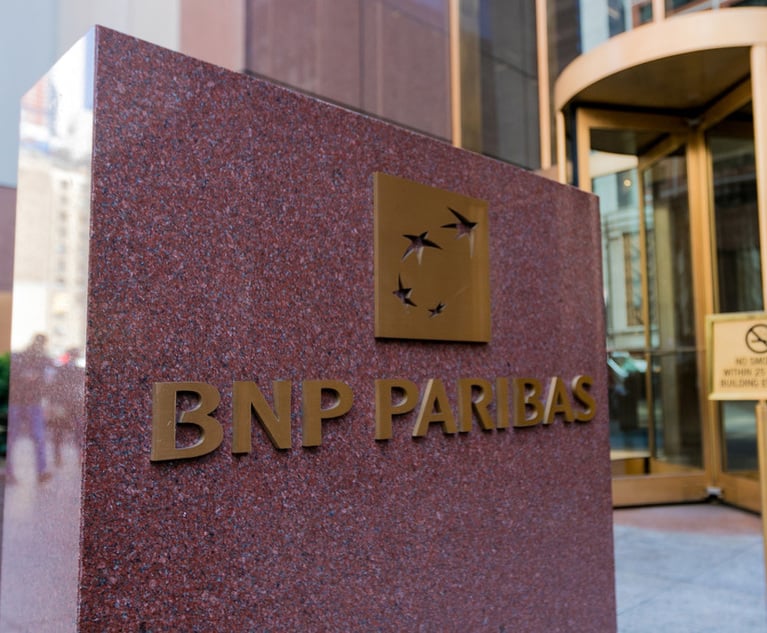2008 and 2020: Can Lessons From the Past Aid Our Markets Today?
Distressed credit funds that invest in bank loans and trade claims should acknowledge lessons from the past financial crisis of 2008. While new problems require new solutions, distressed credit funds can arm themselves in the interim with lessons from the past.
June 17, 2020 at 10:30 AM
7 minute read

Distressed credit funds that invest in bank loans and trade claims should acknowledge lessons from the past financial crisis of 2008. While new problems require new solutions, distressed credit funds can arm themselves in the interim with lessons from the past.
There is one obvious similarity of the credit crisis of 2008 and the economic crisis today: markets collapsed. In 2008, the implosion of the housing market affected the credit markets just as the corona virus swiftly affected our economy with stay at home orders and closures of non-essential businesses. The two different affects similarly dislocated market valuations. Credits that were trading at par, at or near 100 cents on the dollar, are now trading distressed, or below 80 cents on the dollar (even though there isn't a specific line of demarcation at which the trading convention moves from par to distressed). Just like musical chairs, the music stops and creditors that hold par paper may be required to sell loans on distressed trading documents. This happened in 2008 and is happening again today.
For purposes of illustration, a distressed credit fund holds bank loans in a retail company. The past 10 years of an economic boom enabled the retailer to expand globally. The retail company performed well and paid its loan commitments on time. The retail company used leverage to operate its stores, expand its presence online and perhaps build additional brick and mortar stores in high traffic metropolitan locales. A contagion sweeps across the globe, stay at home orders are put into place and non-essential businesses close. Shopping declines and the retailer that was once able to pay its debt as they became due now cannot. The distressed credit fund that held par loans in this company now wants to sell the loans to another secondary market participant.
Looking back to 2008, we know that the distressed credit fund will be expected to sell on distressed trading documentation. What does this mean for the fund? At a minimum, there will be a mismatch in representations, warranties, indemnifications, among other items. The fund will need to provide greater protections to the secondary market participant buyer in a distressed transaction than the seller received when it purchased the loans in the par transaction. Funds seeking to purchase bank debt in today's market should ask for distressed transaction documents. It is important to understand the differences between par and distressed trading documents.
Difference Between Par and Distressed
Distressed transactions require a seller to offer robust and comprehensive representations and warranties in the purchase agreement that are not present in a par transaction. This is key because an investor will not want to provide greater protections in the form of representations and warranties than it received when it purchased the bank loans. The Loan Syndication and Trading Association, or LSTA, provides trading documentation for the majority of the transactions in the secondary loan market on two trading conventions, par and distressed. The LSTA purchase and sale agreement contains a short form agreement that references back to a longer form agreement. There are standard terms and conditions that are incorporated by reference into the short form agreement. It is in these terms that they key distinction between par and distressed transactions lie.
Purchase and Sale Agreement
A par trade settles on a trade confirm and assignment agreement. The assignment agreement is a form that is attached as an exhibit to a credit agreement. A distressed trade settles on an additional document, the purchase and sale agreement (PSA). The PSA contains detailed representations, warranties and indemnifications. These are additional protections that the seller provides the buyer since the credit at issue is in financial distress. The PSA is an agreement that allocates risk between the buyer and seller.
Chain of Title
A distressed transaction contains a chain of title. A buyer can trace how the loans traded and the seller provides a "no bad acts representation" to the buyer. The chain of title will trace each holder of debt to the earliest seller of the debt on distressed paper. The seller assures the buyer that each previous owner made the same representations and warranties up the chain. When a credit shifts from par to distressed, the seller must "step-up" and provide broader representations and warranties than it received.
In addition to providing form trading documents to market participants, the LSTA also provides a shift date poll that polls the market and identifies the date when a credit started trading on distressed documents. The chain of title and related representations in the distressed trade documentation arms the buyer with the ability to track missing distribution payments in a credit and demand the payments from the seller and prior holders of the loan. Other representations and warranties that are present in the distressed trade include protections against set-off and preference payments.
By comparison, a seller offers a clean title representation in a par trade. The purpose of the assignment agreement in a par transaction is to transfer title of the bank loans from seller to buyer. The par trading documents do not offer the same protections as distressed trading documents.
Indemnification
In the PSA, the seller is providing the buyer with a broad indemnification. The seller indemnifies, defends and holds the buyer harmless from any obligation of the buyer to disgorge any payments received in connection with the bank loans. This means if a distribution payment is clawed back from the borrower, the buyer is indemnified by the seller. The seller, who purchased on par trade documentation and is now required by the market to sell the bank loans on distressed trade documentation did not receive this indemnity from its seller.
In 2008, distressed investors learned the hard way of settling on par documents when distressed documents should have been used. The mismatch in representations exposed certain secondary market participants to greater liability. Learning from the past, secondary market participants are now encouraged to purchase on the LSTA's distressed trading documentation in order to benefit from the broad protections afforded in the documents. The representations and warranties, indemnification and other protections, such as the concept of assumed obligations, protect buyers in an uncertain distressed market. The PSA is drafted so that the seller retains all obligations arising or occurring prior to the settlement date of the distressed transaction and from the seller's bad faith, willful misconduct or breach. The distressed documents are truly drafted to address issues that we are seeing now in the distressed markets.
An important difference between the crisis of 2008 and 2020 is the swift response from the government. The recent infusion of capital creates liquidity in the market and opportunities for faltering companies to stabilize. This could create less investment opportunity for distressed credit funds. Once stay at home orders are lifted and testing is readily available, companies may be able to recover. The financial system benefited from financial regulations in 2008 and banks that were then part of the problem can now be a solution. That said, we are seeing a unique time for distressed credit funds to take advantage now of the capital reserved for distressed transactions. Distressed credit funds were forced to sit on the sidelines the past 10 years due to lack of distressed investment opportunities. Now is the time to invest and put the capital to work on the right trading documents.
Conclusion
Looking back to the financial crisis of 2008, distressed credit funds and secondary market participants learned the importance of settling transactions on the proper trading documents. While we cannot apply all lessons from the past to today's economic crisis, it will be interesting to see what new intelligence comes from our current events and how that gets applied going forward in the distressed credit markets and related trading documents.
Jennifer Pastarnack is a partner at Sullivan & Worcester in the NYC office and leads the firm's global debt and claims trading practice.
This content has been archived. It is available through our partners, LexisNexis® and Bloomberg Law.
To view this content, please continue to their sites.
Not a Lexis Subscriber?
Subscribe Now
Not a Bloomberg Law Subscriber?
Subscribe Now
NOT FOR REPRINT
© 2025 ALM Global, LLC, All Rights Reserved. Request academic re-use from www.copyright.com. All other uses, submit a request to [email protected]. For more information visit Asset & Logo Licensing.
You Might Like
View All
'Merciless' Filing Deadline Dooms Cuban Americans' Property-Trafficking Suit Against BNP Paribas, SocGen
4 minute read
Class Certification, Cash-Sweep Cases Among Securities Litigation Trends to Watch in 2025
6 minute read
After 2024's Regulatory Tsunami, Financial Services Firms Hope Storm Clouds Break

GC Pleads Guilty to Embezzling $7.4 Million From 3 Banks
Law Firms Mentioned
Trending Stories
- 1Meta Hires Litigation Strategy Chief, Tapping King & Spalding Partner Who Was Senior DOJ Official in First Trump Term
- 2Courts Beginning to Set Standards for Evidence Relying upon Artificial Intelligence
- 3First-Degree Murder Charge May Not Fit Mangione Case
- 4Legal Tech's Predictions for Legal Ops & In-House in 2025
- 5SDNY US Attorney Damian Williams Lands at Paul Weiss
Who Got The Work
Michael G. Bongiorno, Andrew Scott Dulberg and Elizabeth E. Driscoll from Wilmer Cutler Pickering Hale and Dorr have stepped in to represent Symbotic Inc., an A.I.-enabled technology platform that focuses on increasing supply chain efficiency, and other defendants in a pending shareholder derivative lawsuit. The case, filed Oct. 2 in Massachusetts District Court by the Brown Law Firm on behalf of Stephen Austen, accuses certain officers and directors of misleading investors in regard to Symbotic's potential for margin growth by failing to disclose that the company was not equipped to timely deploy its systems or manage expenses through project delays. The case, assigned to U.S. District Judge Nathaniel M. Gorton, is 1:24-cv-12522, Austen v. Cohen et al.
Who Got The Work
Edmund Polubinski and Marie Killmond of Davis Polk & Wardwell have entered appearances for data platform software development company MongoDB and other defendants in a pending shareholder derivative lawsuit. The action, filed Oct. 7 in New York Southern District Court by the Brown Law Firm, accuses the company's directors and/or officers of falsely expressing confidence in the company’s restructuring of its sales incentive plan and downplaying the severity of decreases in its upfront commitments. The case is 1:24-cv-07594, Roy v. Ittycheria et al.
Who Got The Work
Amy O. Bruchs and Kurt F. Ellison of Michael Best & Friedrich have entered appearances for Epic Systems Corp. in a pending employment discrimination lawsuit. The suit was filed Sept. 7 in Wisconsin Western District Court by Levine Eisberner LLC and Siri & Glimstad on behalf of a project manager who claims that he was wrongfully terminated after applying for a religious exemption to the defendant's COVID-19 vaccine mandate. The case, assigned to U.S. Magistrate Judge Anita Marie Boor, is 3:24-cv-00630, Secker, Nathan v. Epic Systems Corporation.
Who Got The Work
David X. Sullivan, Thomas J. Finn and Gregory A. Hall from McCarter & English have entered appearances for Sunrun Installation Services in a pending civil rights lawsuit. The complaint was filed Sept. 4 in Connecticut District Court by attorney Robert M. Berke on behalf of former employee George Edward Steins, who was arrested and charged with employing an unregistered home improvement salesperson. The complaint alleges that had Sunrun informed the Connecticut Department of Consumer Protection that the plaintiff's employment had ended in 2017 and that he no longer held Sunrun's home improvement contractor license, he would not have been hit with charges, which were dismissed in May 2024. The case, assigned to U.S. District Judge Jeffrey A. Meyer, is 3:24-cv-01423, Steins v. Sunrun, Inc. et al.
Who Got The Work
Greenberg Traurig shareholder Joshua L. Raskin has entered an appearance for boohoo.com UK Ltd. in a pending patent infringement lawsuit. The suit, filed Sept. 3 in Texas Eastern District Court by Rozier Hardt McDonough on behalf of Alto Dynamics, asserts five patents related to an online shopping platform. The case, assigned to U.S. District Judge Rodney Gilstrap, is 2:24-cv-00719, Alto Dynamics, LLC v. boohoo.com UK Limited.
Featured Firms
Law Offices of Gary Martin Hays & Associates, P.C.
(470) 294-1674
Law Offices of Mark E. Salomone
(857) 444-6468
Smith & Hassler
(713) 739-1250






